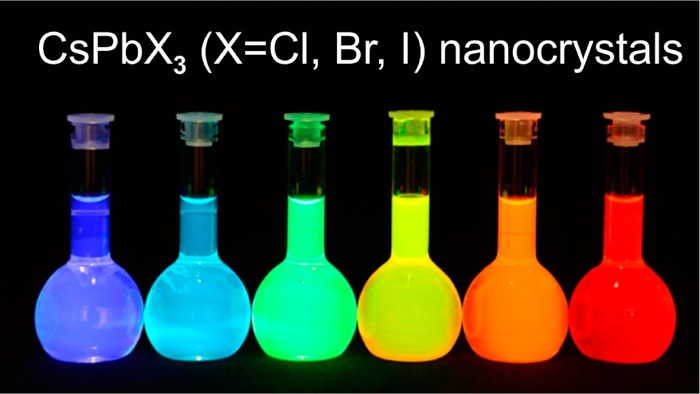- Record: found
- Abstract: found
- Article: not found
Nanocrystals of Cesium Lead Halide Perovskites (CsPbX 3, X = Cl, Br, and I): Novel Optoelectronic Materials Showing Bright Emission with Wide Color Gamut

Abstract

Metal halides perovskites, such as hybrid organic–inorganic CH 3NH 3PbI 3, are newcomer optoelectronic materials that have attracted enormous attention as solution-deposited absorbing layers in solar cells with power conversion efficiencies reaching 20%. Herein we demonstrate a new avenue for halide perovskites by designing highly luminescent perovskite-based colloidal quantum dot materials. We have synthesized monodisperse colloidal nanocubes (4–15 nm edge lengths) of fully inorganic cesium lead halide perovskites (CsPbX 3, X = Cl, Br, and I or mixed halide systems Cl/Br and Br/I) using inexpensive commercial precursors. Through compositional modulations and quantum size-effects, the bandgap energies and emission spectra are readily tunable over the entire visible spectral region of 410–700 nm. The photoluminescence of CsPbX 3 nanocrystals is characterized by narrow emission line-widths of 12–42 nm, wide color gamut covering up to 140% of the NTSC color standard, high quantum yields of up to 90%, and radiative lifetimes in the range of 1–29 ns. The compelling combination of enhanced optical properties and chemical robustness makes CsPbX 3 nanocrystals appealing for optoelectronic applications, particularly for blue and green spectral regions (410–530 nm), where typical metal chalcogenide-based quantum dots suffer from photodegradation.
Related collections
Most cited references18
- Record: found
- Abstract: found
- Article: found
Rapid planetesimal formation in turbulent circumstellar discs
- Record: found
- Abstract: found
- Article: not found
Correlated electron-hole plasma in organometal perovskites.
- Record: found
- Abstract: not found
- Article: not found
